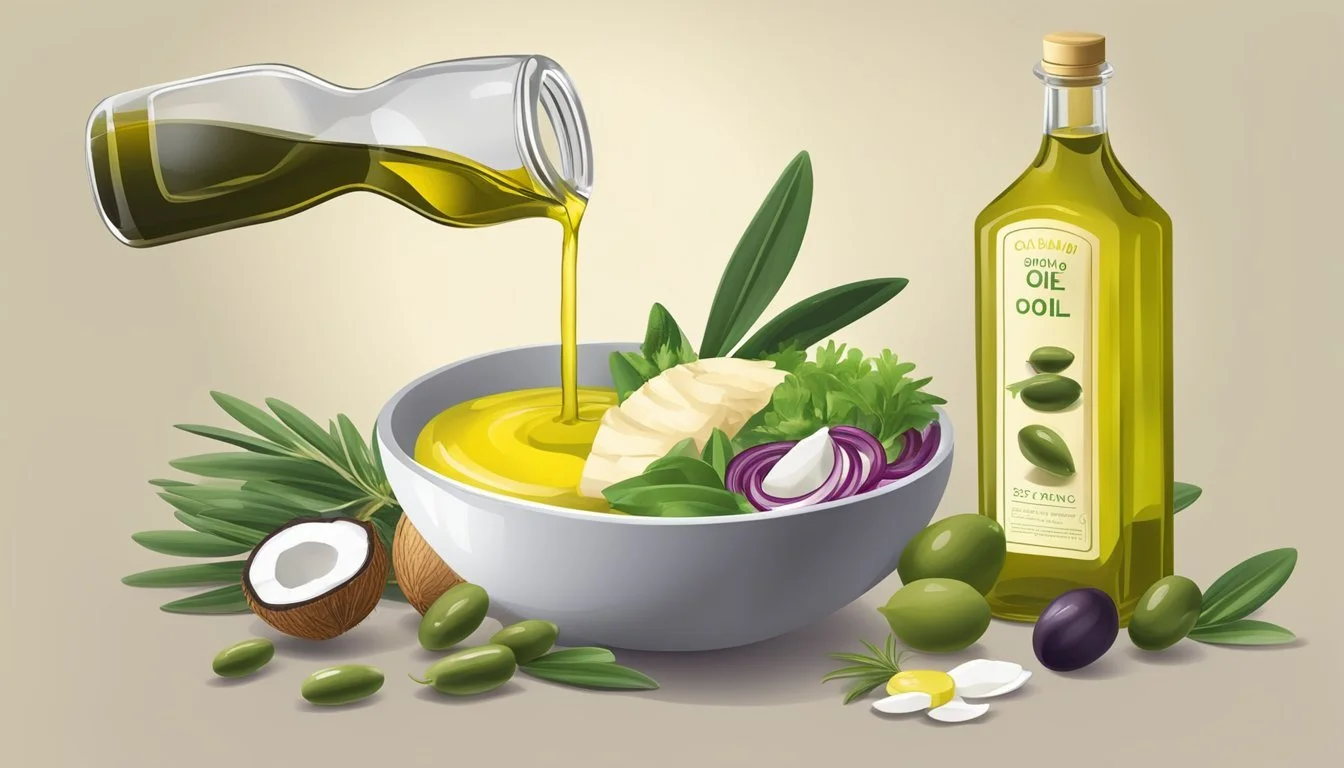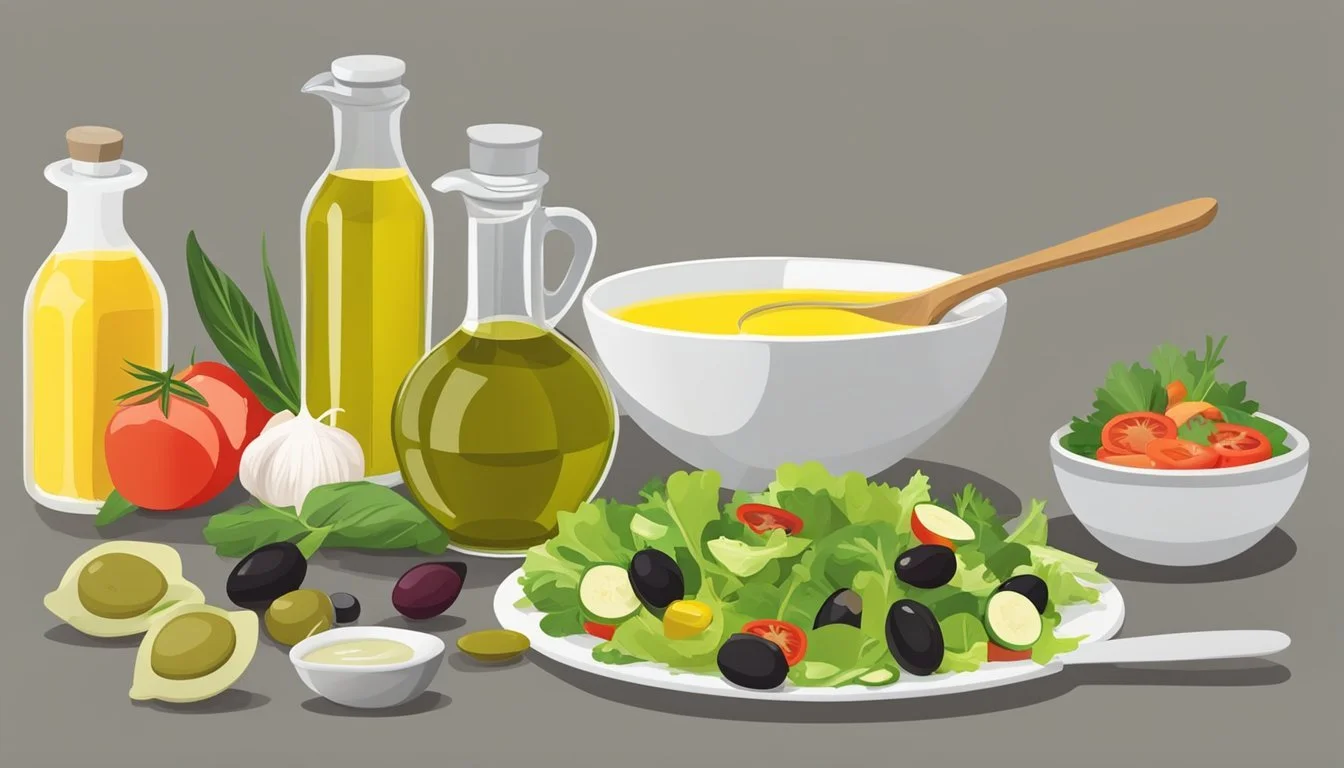How to Substitute Olive Oil for Coconut Oil in Salad Dressing
A Simple Guide
Salad dressings are a crucial component of many salads (What wine goes well with salads?) , providing flavor, moisture, and a satisfying mouthfeel. Olive oil is a traditional base for dressings, appreciated for its health benefits and Mediterranean flavor profile. However, preferences and dietary needs vary, leading some to seek alternatives like coconut oil. When substituting coconut oil for olive oil in salad dressings, one must consider the distinctive taste and consistency of coconut oil, which solidifies at cooler temperatures.
Coconut oil can bring a tropical twist to salad dressings. It pairs well with citrus juices or vinegars and can complement ingredients with sweet or spicy notes. Its health benefits, including the presence of medium-chain triglycerides, are an added advantage. In liquid form, coconut oil can be whisked into dressings just like olive oil, but its unique properties require attention to temperature and pairing choices to ensure the dressing's success on a salad.
Food enthusiasts and health-conscious individuals have experimented with various oils in salad dressings to suit their tastes and nutritional preferences. Coconut oil, with its unique flavor, may not be an exact match for the more neutral taste of olive oil, but it can offer an interesting alternative when used correctly. Moreover, understanding the right ratios and how to handle the oil's texture are important steps to achieving a well-emulsified and flavorsome salad dressing.
Understanding Fats in Salad Dressings
When substituting olive oil for coconut oil in salad dressings, it's essential to consider the health implications and flavor profiles of these fats to ensure the dressing complements the salad without compromising nutritional benefits.
Health Impacts of Olive Oil vs. Coconut Oil
Olive oil, particularly extra virgin olive oil, is renowned for its heart health benefits. It is high in monounsaturated fats, which have been associated with reduced risk of heart disease. In contrast, coconut oil contains a higher percentage of saturated fat, which can have a different impact on heart health. While some studies suggest that the saturated fats in coconut oil may not be as harmful as once thought, it typically raises LDL cholesterol levels in the body, which is considered a risk factor for heart disease.
Nutrition Comparison:
Olive Oil: High in monounsaturated fats, may help reduce heart disease risk.
Coconut Oil: Higher in saturated fats, can raise LDL cholesterol levels.
Flavor Profiles of Olive Oil and Coconut Oil
The flavor of olive oil can vary greatly depending on its type, with extra virgin olive oil having a robust taste that includes peppery, fruity, or grassy notes. Its rich flavor is often a key component in a salad dressing's overall taste. On the other hand, coconut oil has a distinct, sweet, and nutty flavor, which can be overpowering and may not pair well with all salad ingredients.
Flavor Comparison:
Extra Virgin Olive Oil: Strong, can be peppery or fruity.
Coconut Oil: Sweet and nutty, with a potentially overpowering taste.
By considering both the health implications and the distinct flavor profiles, individuals can make informed decisions when substituting fats in salad dressings.
Culinary Uses of Oils in Salad Dressings
In the realm of salad dressings, the choice of oil can significantly affect both the creation process and the flavor profile of the final dressing. Understanding the role oils play is crucial in crafting a dressing that enhances the salad, rather than overpowering it.
Oils' Behaviors in Dressing Emulsification
When making salad dressings, specifically vinaigrettes, emulsification is a key process. This technique involves combining oil with vinegar or another acid so that they form a cohesive mixture. A typical method involves slowly drizzling the oil into the vinegar while continuously whisking in a bowl. Oils with distinct characters, such as olive oil or coconut oil, contribute unique flavor nuances that can either harmonize or contrast with the acid component. However, some oils may emulsify more readily or offer a thinner consistency compared to others, affecting the dressing's stability and mouthfeel.
Coconut oil, when substituted for olive oil, requires careful handling due to its solid state at room temperature. It should be melted and cooled slightly before attempting emulsification.
Olive oil is liquid at room temperature, offering ease of mixing and a generally smooth emulsion.
The emulsifying agent's choice, whether mustard or egg yolk, will work with these oils to create the intended texture.
Impact on Salad Greens and Ingredients
A well-crafted dressing coats salad greens and ingredients evenly without causing them to wilt or become soggy. The oil used in a dressing plays a significant role in this aspect.
Coconut oil: Depending on the dressing recipe, using melted coconut oil that re-solidifies can lead to an uneven coating of the salad ingredients.
Olive oil: It tends to cling to greens and vegetables, providing a pleasing gloss and even distribution.
The type of oil not only impacts the appearance and texture of the salad but also the flavor. A lighter, more neutral oil may let other ingredients, such as herbs or spices, take center stage, while a more robust oil like extra-virgin olive oil can contribute its own peppery or fruity notes to the dish. When substituting coconut oil for olive oil in recipes, chefs should consider both the melting point and flavor profile to ensure the oil complements the other dressing ingredients and salad components harmoniously.
Substituting Olive Oil for Coconut Oil
When making a salad dressing, one can substitute olive oil for coconut oil to achieve a result that still delivers on taste and texture. The following subsections provide specific guidance on how to effectively make this substitution.
Ratios and Measurements for Substitution
For every tablespoon of coconut oil required in the salad dressing recipe, one can use an equal amount of olive oil. This 1:1 ratio maintains the desired consistency of the dressing without the need for additional adjustments.
__Example of Substitution Table:_
Coconut Oil Olive Oil 1 tsp 1 tsp 1 tbsp 1 tbsp 1/4 cup 1/4 cup 1/2 cup 1/2 cup
Adjusting Other Ingredients for Balanced Flavor
Olive oil carries a distinct taste that varies from the neutral profile of coconut oil. To ensure the substitution doesn't overpower the dressing, consider balancing flavors by adjusting other ingredients:
Acid Components: Increase or decrease lemon juice or vinegars to suit the fruitiness of the olive oil.
Sweeteners: Add a dash more honey or a pinch of sugar if required to counter the robustness of olive oil.
Seasonings: Ingredients like garlic, mustard, tahini, salt, and pepper can be fine-tuned to enhance the dressing’s overall flavor profile.
Herbs and Spices: Fresh herbs or a mix of spices can complement the olive oil’s taste and add depth to the dressing.
Through careful tasting and incremental adjustments of these elements, one can tailor the dressing to achieve a harmonious and pleasing taste.
Additional Tips for Salad Dressing Preparation
Proper mixing and storage techniques can greatly enhance the quality of homemade salad dressings. Introducing additional nutrients and flavors into recipes not only boosts the health benefits but also elevates the taste.
Mixing and Storage Techniques
When preparing dressings such as a balsamic vinaigrette, mixing ingredients effectively is crucial for a balanced flavor. Utilizing a glass bowl and a whisk can aid in emulsifying the ingredients, especially when substituting coconut oil for olive oil. As coconut oil solidifies at cooler temperatures, it is advised to gently warm it for a smoother integration.
Storage plays a pivotal role in maintaining the freshness of salad dressings. Dressings should be stored in the refrigerator to extend their shelf life. An airtight container, such as a mason jar or a dedicated dressing container, is ideal to keep the dressings fresh and prevent absorption of other food odors.
Enhancing Dressings with Additional Nutrients and Flavors
To make a vinaigrette more nutritious, consider incorporating elements like minced garlic, which adds not only a robust flavor but also health benefits. Adding honey can provide a touch of natural sweetness while seeds or nut butter can contribute healthy fats and proteins.
Incorporating lemon juice or other citrus can add a zesty freshness while boosting the content of vitamin C. Always taste the dressing after adding new ingredients to ensure a balanced, flavorful profile. The goal is to enhance the taste without overpowering the natural flavors of the salad.
Healthier Alternatives and Variations
When substituting olive oil for coconut oil in salad dressings, one can opt for various healthier alternatives that provide diverse flavors and nutritional benefits, ensuring that the essence of the dressing remains intact while catering to different dietary preferences.
Exploring Nut and Seed Oil Options
Nut and seed oils are excellent substitutes for olive oil due to their rich, nuanced flavors and beneficial nutrient profiles. Here are some specific nut and seed oils that one can consider:
Walnut oil: With a pleasant nutty essence, walnut oil is rich in omega-3 fatty acids, which can enhance heart health.
Sesame oil: Offering a distinctive taste, sesame oil is especially suitable for Asian-inspired dressings, contributing antioxidants and anti-inflammatory properties.
It is important to note that these oils have different flavors and smoke points, which may affect their suitability for various recipes and culinary applications.
Incorporating Unrefined Oils and Vinegars
Unrefined oils and natural vinegars can add complexity and health benefits to salad dressings without the saturated fats found in coconut oil. Some unrefined oils include:
Flaxseed oil: This oil contributes a high nutritional value with its alpha-linolenic acid content, a type of omega-3 fatty acid.
Pumpkin seed oil: Known for its rich mineral content and phytosterols, this oil adds a robust flavor to dressings.
Pairing these oils with different types of vinegars can also vary the flavor profile of a dressing:
Apple cider vinegar: It's celebrated not just for its tangy taste but also for potential health benefits, including blood sugar regulation.
Rice vinegar: Milder and sweeter, rice vinegar can complement subtle flavors without overwhelming other ingredients.
Wine vinegar: Red and white wine vinegars offer a range of flavors, from robust to light, suitable for various salad types.
Including such variations in salad dressings allows individuals to tailor their meals to personal health goals and flavor preferences, all while maintaining the nutritional integrity of their dishes.
Expanding Beyond Salad Dressings
When one substitutes olive oil with coconut oil, it's not just salad dressings that see a transformation. Let's explore how coconut oil proves versatile in various culinary applications.
Cooking: Chefs often use coconut oil for sautéing and roasting due to its stability under high heat. Unlike butter, which has a lower smoke point and can burn more easily, coconut oil remains stable, imparting a subtle, sweet flavor to dishes.
Vegan Baking: In vegan baking, coconut oil serves as a plant-based alternative to butter. Whether it's cakes, cookies, or pastries, coconut oil can be used in equal measure, lending moisture and richness without dairy.
For roasted vegetables, this oil adds a crisp exterior while enhancing their natural sweetness. As a marinade component, coconut oil pairs well with acidic elements, penetrating deeply to tenderize and flavor proteins.
Coconut Oil Use Consideration Sautéing & Roasting High smoke point, adds a subtle sweetness Vegan Baking One-to-one ratio with butter, adds moisture Marinades Complements acidic ingredients, tenderizes
Chefs should be aware that coconut oil solidifies at cooler temperatures, so they may need to warm it slightly for smooth incorporation into recipes. As a culinary fat, coconut oil is not just a substitute but a worthy addition in its own right, enhancing an array of dishes with its unique characteristics.






